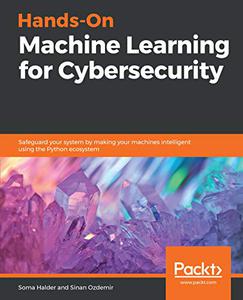
Soma Halder, Sinan Ozdemir, "Hands-On Machine Learning for Cybersecurity: Safeguard your system by making your machines intelligent using the Python ecosystem"
English | 2018 | ISBN: 1788992288 | PDF | pages: 306 | 10.6 mb
Delve into the world of smart data security using machine learning algorithms and Python libraries
Key Features
– Learn machine learning algorithms and cybersecurity fundamentals
– Automate your daily workflow by applying use cases to different aspects of security
– Implement smart machine learning solutions to detect various cybersecurity problems
Book Description
Organizations are increasingly vulnerable to many cybersecurity threats which can lead to significant financial losses, making smart data security more important than ever. In this book, you’ll use different tools and techniques to solve a variety of significant problems that exist in the cybersecurity domain.
The book begins by introducing you to the basics of machine learning in cybersecurity using Python and its libraries. You will then explore various machine learning domains, such as time series analysis and ensemble modeling. As you progress, you will implement various examples such as building a system to identify malicious URLs, and creating a program to detect fraudulent emails and spam. Later, you will learn how to make effective use of the k-means algorithm to develop a solution for detecting and alerting you about any malicious activity in the network. In addition to this, you’ll get up to speed with implementing biometric authentication and fingerprint scanning to validate whether someone is a legitimate user or not. Finally, you will see how you can use TensorFlow for cybersecurity, along with understanding how deep learning is effective for creating models and training systems.
By the end of this book, you will have learned how to effectively use the Python ecosystem and machine learning algorithms for cybersecurity.
What you will learn
– Get to grips with how machine learning and Python can be used in complex cyber issues
– Apply machine learning algorithms with complex datasets to implement cybersecurity concepts
– Implement machine learning algorithms such as clustering, k-means, and Naive Bayes to solve real-world problems
– Learn to speed up a system using Python libraries with NumPy, scikit-learn, and CUDA
– Mitigate cyber crimes by understanding how to combat malware, detect spam, and fight financial fraud
– Use TensorFlow in the cybersecurity domain and implement real-world examples
Who this book is for
This book is for data scientists, machine learning developers, security researchers, or anyone looking to apply machine learning for computer security. Having some working knowledge of Python programming and familiarity with machine learning and cybersecurity fundamentals will help you get the most out of this book.
Table of Contents
– Basics of Machine Learning in Cybersecurity
– Time Series Analysis and Ensemble Modeling
– Segregating Legitimate and Lousy URLs
– Knocking Down CAPTCHAs
– Using Data Science to Catch Email Fraud and Spam
– Efficient Network Anomaly Detection Using K-Means
– Decision Tree and Context-Based Malicious Event Detection
– Catching Impersonators and Hackers Red-Handed
– Change the Game with TensorFlow
– Financial Fraud and How Deep Learning Can Mitigate Them
– Practical Case Studies in Cybersecurity
Download From 1DL
DOWNLOAD FROM 1DL.NET
DOWNLOAD FROM RAPIDGATOR.NET
DOWNLOAD FROM NITROFLARE.COM
DOWNLOAD FROM UPLOADGIG.COM



